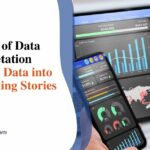Data Storytelling: Unleashing the Power of Visual Narratives

Introduction
Welcome to our comprehensive guide on data storytelling, where we explore the art of transforming complex data into captivating narratives. In today’s data-driven world, organizations that can effectively communicate their insights have a competitive edge. By mastering the techniques of data storytelling, you can engage your audience, convey your message with impact, and stand out in the digital landscape.
The Importance of Data Storytelling
Data storytelling is an essential skill that enables you to go beyond mere data presentation. It allows you to weave a compelling narrative around your data, making it more accessible and relatable to your audience. By combining the analytical power of data with the emotional appeal of storytelling, you can create a memorable experience that resonates with your readers.
Engaging your Audience
To captivate your audience, it is crucial to understand their needs and preferences. Craft your data story in a way that appeals to their interests, pain points, or aspirations. By aligning your narrative with their expectations, you can effectively capture their attention and maintain engagement throughout your content.
Simplifying Complex Data
Data can be overwhelming, especially when presented in raw form. Data storytelling involves simplifying complex information and transforming it into a coherent, easy-to-understand narrative. Break down your data into digestible chunks, use visual aids such as charts, graphs, and diagrams, and provide clear explanations to guide your readers through the story.
Making Data Relevant and Relatable
The true power of data storytelling lies in its ability to make data relatable and relevant to your audience. Connect your data to real-world scenarios, anecdotes, or examples that your readers can easily grasp. By doing so, you establish a personal connection, evoke emotions, and foster a deeper understanding of the insights you are presenting.
Key Elements of Effective Data Storytelling
To create a data story that resonates with your audience and outranks your competitors, it is important to pay attention to the key elements of effective storytelling. Let’s explore each element in detail:
1. A Compelling Narrative Arc
A compelling narrative arc provides structure and direction to your data story. It typically consists of three key components: the setup, the confrontation, and the resolution. Begin by setting the context, introducing the problem or question you aim to address, building tension through conflict or challenges, and concluding with a satisfying resolution that ties back to your data insights.
2. Visual Representation of Data
Visual aids play a crucial role in data storytelling. They enable you to present complex information in a visually appealing and easily understandable format. Utilize charts, graphs, infographics, and diagrams to illustrate patterns, trends, or correlations within your data. Visuals not only enhance comprehension but also add visual interest to your content, keeping your readers engaged.
3. Contextualizing the Data
Context is key in data storytelling. Provide background information, explain the data sources, and highlight any relevant external factors that might have influenced the data. Contextualizing your data helps your audience understand the significance of the insights and reinforces the credibility of your narrative.
4. Emotion and Human Connection
Data alone may not evoke an emotional response from your audience. However, by humanizing your data and connecting it to real-life situations, you can tap into the emotional aspect of storytelling. Incorporate personal anecdotes, case studies, or testimonials to create empathy and establish a stronger connection with your readers.
5. Clear and Actionable Insights
Data storytelling should not only inform but also inspire action. Conclude your narrative with clear and actionable insights that empower your audience to make informed decisions or take specific steps. Whether it’s optimizing business strategies, identifying growth opportunities, or addressing challenges, your data story should provide practical value to your readers.
Conclusion
Mastering the art of data storytelling allows you to harness the power of visual narratives to captivate your audience, simplify complex data, and make it relevant and relatable. By understanding the key elements of effective storytelling and implementing them in your content, you can outrank your competitors and establish your brand as a trusted authority in your field.
Remember, data storytelling is not just about presenting numbers—it’s about telling a story that engages, enlightens, and empowers. Embrace the creative possibilities of data storytelling, and watch as your content rises to the top of search engine rankings, driving organic traffic and delivering impactful results for your organization.
So, are you ready to embark on a data storytelling journey that will transform the way you communicate with your audience? Start crafting your narrative today and unleash the full potential of your data-driven insights.







